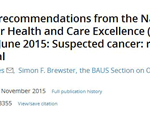Guideline of guidelines: a review of urological trauma guidelines
Objective
To review the guidelines released in the last decade by several organisations for the optimal evaluation and management of genitourinary injuries (renal, ureteric, bladder, urethral and genital).
Methods
This is a review of the genitourinary trauma guidelines from the European Association of Urology (EAU) and the American Urological Association (AUA), and renal trauma guidelines from the Société Internationale d’Urologie (SIU).
Results
Most recommendations are guided by the American Association for the Surgery of Trauma (AAST) organ injury severity system. Grade A evidence is rare in genitourinary trauma, and most recommendations are based on Grade B or C evidence. The findings of the most recent urological trauma guidelines are summarised. All guidelines recommend conservative management for low-grade injuries. The major difference is for haemodynamically stable patients who have high-grade renal trauma; the SIU guidelines recommend exploratory laparotomy, the EAU guidelines recommend renal exploration only if the injury is vascular, and the AUA guidelines recommend initial conservative management.
Conclusion
There is generally consensus among the three guidelines. Recommendations are based on observational or retrospective studies, as well as clinical principles and expert opinions. Multi-institutional collaborative research can improve the quality of evidence and direct more effective evaluation and management of urological trauma.




